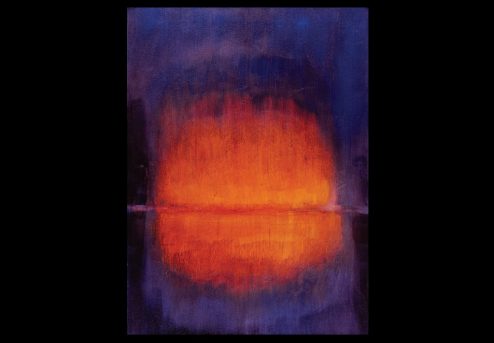SACRED PLACES
“THE TEMPLE’S MOST SACRED SPOT IS ITS INNER SANCTUM — A NARROW, UNLIT SPACE WHERE THE DEITY SITS AND DEVOTEES FLOCK. IN SACRED PLACES, OOMMEN SEEKS TO RECREATE THIS JOURNEY OF FAITH, TOWARDS A LIVING, CENTRAL CORE OF AWARENESS.”
Palls of darkness. Caves of light. From galleys of colour, darkening and brightening, appear rims of fire. The artist knows these galleys. He has explored them over and over again. With care and patience, he has tested their variety and learned their depth. In Sacred Places Within You, we see George Oommen’s most intimate and tender conversations with color. The paintings range from medium size to miniature, but even the smallest of these have a depth and movement that is simultaneously removed and sensual. The eye is caught in a storm of brushstrokes, in an incessant chromatic discussion. Resolution appears in a bright burst of color that occupies the center of the canvas, lifting away the dense build-up of strokes and color around it.
Oommen has described these paintings as his most personal work, the very essence of who he is. The paintings move from dark to light, evocating the artist’s own inner quest. Oommen was moved to create the Sacred Places paintings by a scene in a Louise Malle film called Phantom India. The scene consists of a young temple dancer, moving with such divine rapture and focus that Oommen was driven to recreate the intensity of her performance. A Sacred Places painting is similarly active, and alive with the movement of brushstrokes and color. Out of this energy, the artist kindles the flame of spirituality.
The paintings were inspired also by Oommen’s visits to an old Hindu temple in Kerala. The temple’s most sacred spot is its inner sanctum — a narrow, unlit space where the deity sits and devotees flock. In Sacred Places, Oommen seeks to recreate this journey of faith, towards a blazing, central core of awareness. We join the artist in his search for clarity; as he excavates color and light, we step into our own interiority and remain there, watching and learning from their progression. Stirred by the vibration of color, we are surprised to find at the heart of the painting an echo of the spirit that stirs within us.
As the artist uncovers color from color, gold from flurries of blue and fiery oranges from violet-black, the chromatic discussion functions like a sieve; in contemplating it, we work through the canvas’ noise and tumult towards a simmering center. Sacred Places is a clear aesthetic departure from the light-filled, profuse landscapes of the Kerala series. Here, Oommen explores the landscape of the mind. Color becomes an artifact that he examines by teasing out its subtleties. Color becomes a mesh for us to spin in and out of, fall in and spring off, meditating, engaging and releasing. A rich brown background (SP011) blends into a flame-coloured center; the likeness to fire gives pause and one is compelled to stop and ponder its mystery.
Far from being playful, nostalgic or intellectual, Sacred Places remains a deeply personal foray into the study of color. The paintings are representative of the painter’s attachment to color in the way that a writer is attached to language; they reveal a man drawn to its power, of a mind prepared to listen and be disarmed and subdued by it. In becoming aware of color, we become aware of a piece of our own consciousness.
- Within You, 2012
- Within You, 2003
- Sacred Places, 1995
- Within You, 1995
- Sacred Places, 1995
- Within you, 2022
In the early 1970s, Oommen saw a series of films by Louise Malle titled “Phantom India”. One featured a young girl in a Hindu temple, performing with an intensity that deeply impressed Oommen. Later visiting a temple, he was struck by the architecture of its inner sanctum. Oommen, who was raised a Christian, found that unlike the floodlit altars in churches, the temple is entered from a larger, well-lit space to a much smaller, dark space where the only source of light is the gleaming idol. “You’re in a space where you completely lose your peripheral vision and you can hear your heartbeat.” This inspired Oommen to create “Sacred Places Within You”, paintings where he literally excavates a bright, saturated spot of colour from a surrounding darkness.
A “Sacred Places” painting collapses the viewer’s sense of space, chipping away at it till there is nothing but canvas and the discussion of colour and light within. It demands quiet contemplation before granting an understated grace. After creating more than 60 pieces, Oommen now owns only four or five that he will not part with. It is among his most successful and resonant series.





